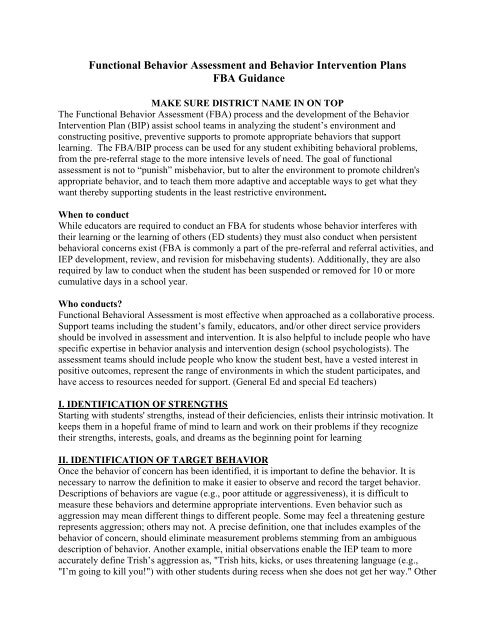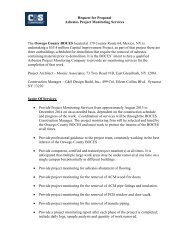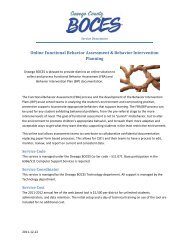Functional Behavior Assessment and Behavior Intervention Plans ...
Functional Behavior Assessment and Behavior Intervention Plans ...
Functional Behavior Assessment and Behavior Intervention Plans ...
Create successful ePaper yourself
Turn your PDF publications into a flip-book with our unique Google optimized e-Paper software.
<strong>Functional</strong> <strong>Behavior</strong> <strong>Assessment</strong> <strong>and</strong> <strong>Behavior</strong> <strong>Intervention</strong> <strong>Plans</strong><br />
FBA Guidance<br />
MAKE SURE DISTRICT NAME IN ON TOP<br />
The <strong>Functional</strong> <strong>Behavior</strong> <strong>Assessment</strong> (FBA) process <strong>and</strong> the development of the <strong>Behavior</strong><br />
<strong>Intervention</strong> Plan (BIP) assist school teams in analyzing the student’s environment <strong>and</strong><br />
constructing positive, preventive supports to promote appropriate behaviors that support<br />
learning. The FBA/BIP process can be used for any student exhibiting behavioral problems,<br />
from the pre-referral stage to the more intensive levels of need. The goal of functional<br />
assessment is not to “punish” misbehavior, but to alter the environment to promote children's<br />
appropriate behavior, <strong>and</strong> to teach them more adaptive <strong>and</strong> acceptable ways to get what they<br />
want thereby supporting students in the least restrictive environment.<br />
When to conduct<br />
While educators are required to conduct an FBA for students whose behavior interferes with<br />
their learning or the learning of others (ED students) they must also conduct when persistent<br />
behavioral concerns exist (FBA is commonly a part of the pre-referral <strong>and</strong> referral activities, <strong>and</strong><br />
IEP development, review, <strong>and</strong> revision for misbehaving students). Additionally, they are also<br />
required by law to conduct when the student has been suspended or removed for 10 or more<br />
cumulative days in a school year.<br />
Who conducts?<br />
<strong>Functional</strong> <strong>Behavior</strong>al <strong>Assessment</strong> is most effective when approached as a collaborative process.<br />
Support teams including the student’s family, educators, <strong>and</strong>/or other direct service providers<br />
should be involved in assessment <strong>and</strong> intervention. It is also helpful to include people who have<br />
specific expertise in behavior analysis <strong>and</strong> intervention design (school psychologists). The<br />
assessment teams should include people who know the student best, have a vested interest in<br />
positive outcomes, represent the range of environments in which the student participates, <strong>and</strong><br />
have access to resources needed for support. (General Ed <strong>and</strong> special Ed teachers)<br />
I. IDENTIFICATION OF STRENGTHS<br />
Starting with students' strengths, instead of their deficiencies, enlists their intrinsic motivation. It<br />
keeps them in a hopeful frame of mind to learn <strong>and</strong> work on their problems if they recognize<br />
their strengths, interests, goals, <strong>and</strong> dreams as the beginning point for learning<br />
II. IDENTIFICATION OF TARGET BEHAVIOR<br />
Once the behavior of concern has been identified, it is important to define the behavior. It is<br />
necessary to narrow the definition to make it easier to observe <strong>and</strong> record the target behavior.<br />
Descriptions of behaviors are vague (e.g., poor attitude or aggressiveness), it is difficult to<br />
measure these behaviors <strong>and</strong> determine appropriate interventions. Even behavior such as<br />
aggression may mean different things to different people. Some may feel a threatening gesture<br />
represents aggression; others may not. A precise definition, one that includes examples of the<br />
behavior of concern, should eliminate measurement problems stemming from an ambiguous<br />
description of behavior. Another example, initial observations enable the IEP team to more<br />
accurately define Trish’s aggression as, "Trish hits, kicks, or uses threatening language (e.g.,<br />
"I’m going to kill you!") with other students during recess when she does not get her way." Other
examples of well-defined behavior include defining verbal off-task behavior as: "Charles makes<br />
irrelevant <strong>and</strong> inappropriate comments during reading class (e.g., "This is dumb." or "Anyone<br />
could do that."); <strong>and</strong> hyperactivity as: "Jan leaves her assigned area without permission (e.g.,<br />
walks around class, goes to reward area of class), completes only small portions of her<br />
independent work (e.g., 3 of 10 problems), <strong>and</strong> blurts out answers without raising her h<strong>and</strong>.<br />
III. BACKGROUND INFORMATION RELEVANT TO THE TARGET BEHAVIOR<br />
Review of Pertinent Records<br />
A review of a student's records involves analysis of the history related to the target behavior.<br />
Information from the student's files may provide details that help examiners underst<strong>and</strong> why the<br />
child is having difficulties in school. May include; Attendance records, Grade reports, Discipline<br />
<strong>and</strong> behavior records. Sample record reviews are included in<br />
ATTACHMENTS A<br />
Previous <strong>Intervention</strong>s <strong>and</strong> Outcomes<br />
Pre referral documentation may include when staff started to intervene, what interventions were<br />
tried, for how long, with what results <strong>and</strong> how they're documented, etc. Anecdotal records of<br />
changes made, differentiation provided, interventions tried – along with their results – should be<br />
maintained. When a teacher <strong>and</strong> other school staff have been providing <strong>and</strong> documenting<br />
interventions <strong>and</strong> progress monitoring for a student for some time, the process itself calls for a<br />
continuous gathering, analyzing <strong>and</strong> summarizing of data. Samples-<br />
ATTACHMENTS B<br />
Summary of Interviews (parent, staff, student)<br />
Interviewing with the student <strong>and</strong>/or parent along with targeted staff members is recommended.<br />
Sample interviews ate included in<br />
ATTACHMENTS C<br />
Other relevant information (including cognitive, affective <strong>and</strong> environmental conditions)<br />
This information may be based upon previous psychological information, social history, health<br />
information or involved agency information<br />
IV. OBSERVATION OF TARGETED BEHAVIOR<br />
In collecting information to refine the definition about behavior, it is necessary to observe the<br />
student in various settings (e.g., classroom, cafeteria, playground, <strong>and</strong> other social settings),<br />
during different types of activities (e.g., individual, large group, or cooperative learning), <strong>and</strong> to<br />
discuss the student’s behavior with other school personnel or family members. This will help the<br />
team to determine the exact nature of the behavior <strong>and</strong> to narrow its scope of the examination of<br />
the problem situation.<br />
Date Location Observer Notes<br />
Some sample observation forms are included in ATTACHMENT D
Baseline Frequency<br />
Intensity<br />
Mark all that apply<br />
____ Distractive<br />
Low Med High<br />
____ Disruptive<br />
Low Med High<br />
____ Destructive<br />
Low Med High<br />
Misbehavior is an<br />
emotional state that<br />
varies in intensity<br />
from mild irritation<br />
(distraction) to<br />
intense fury <strong>and</strong> rage<br />
(destruction).<br />
Disruptive behavior<br />
is difficult to define<br />
as each situation has<br />
to be evaluated in<br />
context of the<br />
occurrence<br />
Duration<br />
This section<br />
provides the<br />
details on how<br />
long this<br />
behavior had<br />
been occurring.<br />
Exact data<br />
needs to be<br />
recorded.<br />
Examples<br />
include; since<br />
Sept. 11, three<br />
times a day for<br />
two weeks<br />
Educational Impact<br />
How does this behavior<br />
impact the individual<br />
student’s performance<br />
<strong>and</strong>/or the achievement<br />
of others in the class?<br />
Specific data not just<br />
perceptions are helpful.<br />
V. IDENTIFYY THE FACTORS SURROUNDING THE TARGETED BEHAVIOR<br />
Indicate the possible predisposing factors, triggers (antecedent), concurrent events <strong>and</strong> outcomes<br />
that provide the context for the current behavior.<br />
Possible<br />
Predisposing<br />
Factors<br />
Possible<br />
factors that<br />
may contribute<br />
to the behavior:<br />
**Awareness<br />
<strong>and</strong><br />
Knowledge<br />
**Beliefs<br />
**Values-<br />
**Attitudes-<br />
**Social<br />
/Family<br />
situations-<br />
**Existing<br />
Setting/Concurrent<br />
Events<br />
Some situations to<br />
consider may<br />
include:<br />
**events or<br />
conditions that<br />
typically occur<br />
before the behavior<br />
**events or<br />
conditions that<br />
typically occur after<br />
the behavior<br />
**common setting<br />
events<br />
**in small <strong>and</strong> large<br />
Antecedent<br />
(Trigger)<br />
Must determine<br />
if specific<br />
environmental<br />
antecedents are<br />
associated with<br />
the targeted<br />
behavior. There<br />
are fast <strong>and</strong><br />
slow triggers<br />
Outcome<br />
When the target<br />
behavior occurs<br />
what happens<br />
after. Are there<br />
consequences?<br />
What are the<br />
“payoffs” the<br />
student is<br />
receiving from<br />
the behavior?<br />
Possible Function<br />
of <strong>Behavior</strong><br />
** Lack of ability<br />
or skill.<br />
**Awareness<br />
**Attentionseeking—<br />
**Competing<br />
**Power/Control—<br />
**Venting<br />
frustration or anger<br />
**Escape
Skills<br />
group situations<br />
**structured <strong>and</strong><br />
unstructured<br />
situations<br />
Sample<br />
determinations<br />
ATTACHMENTS<br />
E<br />
VI. DEVELOP A FUNCTIONAL HYPOTHESIS<br />
Using the information that emerges from data analysis, the team develops a hypothesis statement<br />
regarding the likely function(s) of the student behavior. The hypothesis statement can then be<br />
used to predict the social/environmental conditions (the context) within which the behavior is<br />
most likely to occur. Only when the function(s) of the behavior is (are) known is it possible for<br />
the team to establish an effective behavioral intervention <strong>and</strong> support plan. The hypothesis<br />
statement is a concise summary of information collected during the assessment phase, a<br />
statement that explains or represents a "best guess" regarding the reason(s) for the behavior. A<br />
well-written hypothesis statement gives clear direction to members who are responsible for<br />
developing a behavior intervention plan. Here are a few examples:<br />
o<br />
o<br />
o<br />
Charles disrupts reading class by swearing at the teacher when he is asked to read aloud.<br />
He is most likely to disrupt the class if he has not had breakfast or if there was a problem<br />
at the bus stop. Charles stops swearing when he is told to leave the group.<br />
When she does not get what she wants from her peers, Trish calls them names <strong>and</strong> hits<br />
them until they give in to her dem<strong>and</strong>s.<br />
Juan verbally threatens the teacher when he is given a math assignment that he sees as too<br />
lengthy <strong>and</strong> too difficult, but stops when he is told to find something else to do.<br />
VI. POSITIVE PREVENTIVE STRATEGIES<br />
Determine the student’s strengths, <strong>and</strong> known reinforces in order to target specific<br />
alternative/replacement behaviors. Effective behavior programs are based on the idea that an<br />
early response to a problem leads to better outcomes for students <strong>and</strong> teachers. The FBA will<br />
give educators practical <strong>and</strong> specific strategies to build successful positive, preventive programs<br />
in schools.<br />
What positive behaviors, activities <strong>and</strong> or roles could replace the problem behaviors<br />
<strong>and</strong> still serve the same function for the child?<br />
Replacement behaviors may include (e.g., communicative alternatives that provide an immediate<br />
mechanism for ones. An intervention plan should target specific skills <strong>and</strong> what will be taught to<br />
allow an individual to meet his or her objectives in a person to meet their needs) <strong>and</strong> other skills<br />
that improve overall functioning (e.g., independent living, social skills, leisure/recreation,<br />
tolerance). Replacement skills must be taught systematically <strong>and</strong> effectively. Systematic<br />
instruction involves using effective instructional cues, analyzing <strong>and</strong> breaking down task<br />
components, employing appropriate teaching methods (e.g., prompting, shaping, <strong>and</strong> fading<br />
procedures), <strong>and</strong> rewarding <strong>and</strong> correcting behaviors consistently. Failure of a person to develop<br />
the desired skills should prompt a reassessment of these teaching methods<br />
<br />
When, where <strong>and</strong> with whom is the problem behavior typically not displayed?
Base on schedules, record review, discipline documents <strong>and</strong> interviews are there any staff,<br />
subjects, <strong>and</strong> times of the day or situations when the problems do not exist.<br />
Based on formal <strong>and</strong> informal assessments, what reinforces might be most<br />
successful in helping to motivate the student?<br />
This can be determined informally by asking the student during the interview process a series of<br />
questions on interests, likes <strong>and</strong> dislikes that may be used as incentives in the BIP, More formal<br />
reinforcement surveys are available in ATTACHMENTS F.<br />
.<br />
BIP Guidance<br />
MAKE SURE DISTRICT NAME AND CURRENT SCHOOL YEAR IN ON THE TOP<br />
BIP’s are designed to give teachers ways to counter behavioral problems with practices that that<br />
have proven effective in all school settings.<br />
Name, DOB, Date<br />
Student’s name, date of birth <strong>and</strong> date plan is being implemented<br />
Box in top right h<strong>and</strong> corner is to indicate if this plan is an initial BIP. Or what number<br />
revision we are in.<br />
Hypothesis:<br />
This is taken directly from the FBA Part VI<br />
Target <strong>Behavior</strong><br />
State in one or two words what the target behavior is on the given line<br />
Current level- Baseline data of the targeted behavior<br />
Goal Level- Anticipated short term change to the target behavior as the result of the intervention.<br />
Date to follow up <strong>and</strong> measure will be helpful<br />
Prevention Strategies<br />
To head off trouble, first look for the signs that something many be about to happen. The best<br />
way to h<strong>and</strong>le a problem is to prevent the problem. This is true in managing misbehavior in<br />
students. Without prevention strategies staff will certainly run around dousing one blaze after<br />
another; but underst<strong>and</strong>ing why the student misbehaved can help prevent many problems from<br />
the start. Think about what can be done to interfere with the target behavior as well as what<br />
positives we can give students to change the cycle of negativity. The goal is not to have an<br />
exhaustive list but to target one or two things that will be consistently done by staff. Use<br />
information from motivation <strong>and</strong> reinforcement inventories to build prevention strategies.<br />
Alternative <strong>Behavior</strong>s to be taught A replacement behavior is an appropriate behavior that the<br />
child can perform that accomplishes the same goal as the inappropriate behavior. Without
teaching a child a replacement behavior, meaningful, positive changes in behavior will be<br />
difficult, if not impossible, to obtain. It is unrealistic to expect anyone to stop doing something<br />
that works for them without giving them something to do in exchange. If an individual hurts<br />
herself to escape from the noise <strong>and</strong> the crowd of the dinner table, then she should be taught<br />
another, equally effective way she can ask to be excused from the table. This could be signing,<br />
pointing to a symbol taped to the table, or pressing a button on a communication device.<br />
Teachers MUST directly instruct, model, practice <strong>and</strong> reinforce the new behavior. Again we will<br />
teach one new replacement at a time.<br />
Who When <strong>and</strong> How<br />
To yield results there needs to be cooperation among school, parents, <strong>and</strong> children. All three<br />
have important roles <strong>and</strong> responsibilities in an intervention plan. The BIP must spell out who is<br />
responsible for doing what so that no misunderst<strong>and</strong>ings happen. The goal is a shared<br />
responsibility with multiple people supporting the student.<br />
Crisis Management Steps Safe crisis management procedures are needed <strong>and</strong> should be planned<br />
for thoroughly in advance. It is important to remember that the goals of crisis management<br />
procedures are to ensure the safety of the student <strong>and</strong> all others, <strong>and</strong> to de-escalate the problem as<br />
rapidly as possible. Rapid response ensures the safety of all involved not an attempt to change<br />
behavior with punitive or reactive. These are to be written in steps that would escalate in<br />
intensity. Do not forget time out if you are going to use that must be spelled out.<br />
ATTACHMENT G<br />
Monitoring Schedule How often will data be collected on the behavior after the interventions are<br />
in place, additionally a date needs to be established to meet again to review the plan <strong>and</strong> analyze<br />
the data collected. Progress must be reported on the goals <strong>and</strong> progress of this plan to parents just<br />
as we do for IEP goals.<br />
Person Responsible It must be spelled out as to who will collect data in classes <strong>and</strong> who will<br />
summarize the data that teachers collect.<br />
<strong>Intervention</strong> Progress Notes<br />
Measuring changes in behavior <strong>and</strong> improvements in a student’s quality of life (e.g.,<br />
participation in integrated activities, improved social relationships, independence <strong>and</strong> selfsufficiency)<br />
needs to happen on a regular basis. Individual BIPs include objective methods for<br />
evaluating these outcomes, <strong>and</strong> determining adjustments that might be warranted when progress<br />
does not occur within the time frame established at the initial meeting.<br />
Dates: When reviewed<br />
Progress monitoring codes similar to what is used in IEP Direct<br />
Data: Summarized new data on the target behavior<br />
Summary: Recommendations for next step, changes or modifications that need to take place to<br />
make this student successful. Circle what will happen next; continue, revise, rewrite or<br />
discontinue







